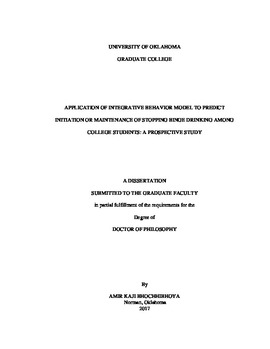| dc.description.abstract | With the heightened risk for serious social and physiological consequences, binge drinking is arguably the single most important preventable cause of morbidity and mortality among college students. The negative consequences of drinking alcohol such as violence, unprotected and unplanned sexual intercourse, injury and death from accidents significantly increases when one indulges in binge drinking. Yet, the number of drinks (9.3 drinks on each occasion) and prevalence (40%) of binge drinking, both are highest among the college-aged population. To address this health concern, there have been significant public health efforts over the past two decades, but the status of college student binge drinking has not improved. Thus, identifying additional predictive variables is warranted to enhance the effectiveness of the interventions. The purpose of this study to explore various constructs of the Integrative Behavior Model (IBM) and identify major constructs that best predicts binge drinking behavior among college students with different drinking pattern i.e. binge drinker, social drinkers, and abstainers and assist in customizing future interventions for each of these groups.
This study utilized a prospective study design with two points at the interval of 30 days. The study sample included undergraduate students from a Southwestern University. A new survey was developed and utilized to understand theory-based determinants of the drinking behaviors. A pilot survey was conducted among 46 participants to evaluate the feasibility of recruitment, retention, assessment procedures, and implementation of the study. After refining the survey, the study was implemented to collect responses from 870 participants in time 1, however after eliminating incomplete data and matching responses at time 2, only 388 responses were considered for final analysis which included 161 binge drinkers, 72 social drinkers, and 155 abstainers. Results indicated certain demographic groups drank at disproportionately higher rates which suggested at-risk groups such as African Americans compared to other ethnic groups, atheist compared to participants with religious beliefs, and age group 18-20 compared to other age groups. The IBM model significantly predicted behavioral intentions towards stopping binge drinking for binge drinkers (48.1%) as well as continuing not to binge drinking for non-binge drinkers (28.2%). Further, when non-binge drinkers were categorized as social drinkers and abstainers, IBM model predicted 60.7% 6% of the intention towards continuing not to binge drinking for social drinkers and abstainers respectively. IBM model also significantly predicted 16.6% of the drinking behavior for binge drinkers and 14.8% for non-binge drinkers.
In conclusion, the current study shows promising application of IBM in predicting and explaining binge drinking behavior among college students and furnish with the predictive factors to design effective interventions. Further, this study highlighted the need for customizing interventions based on students drinking behavior i.e. binge drinkers, social drinkers, and abstainers. This study also suggested the need to redefining few aspects of the IBM in the future studies as two components model resulted more effective than one component model for measuring attitudes, perceived norms, and perceived behavioral control. Future research needs to be conducted to determine the efficacy of the IBM for other populations, settings and health behaviors. | en_US |
